______________________________
Today on 52nd Street in New York City, lawyer Mr. Kei Komuro and his employee Mrs. Mako Metropolitan Museum. Just a year ago, she moved from a palace in Tokyo’s imperial district to a rented one-room apartment in Manhattan.
The Japanese imperial family is the oldest hereditary royal family in the world and has been in tradition for a thousand years. One of them does not allow women to remain royals if they are not married to the offspring of monarchs or aristocrats. If a woman from the imperial family wants to marry a commoner, she has to make a choice: either life with her loved one, or the status of royalty and position in the family and society. Moreover, this rule does not apply to men. Or rather, it is no longer distributed.
The retired Emperor Akihito, the grandfather of the former Princess Mako, married in 1959 the daughter of the president of the Michiko flour mill, in defiance of tradition. It was the first such case in history. Nevertheless, the heir to the throne managed to secure the approval of the Office of the Imperial Court of Japan, and subsequently marriage to a commoner did not prevent him from becoming emperor and occupying the Chrysanthemum throne for 30 years. It must be said that Mako is the first and beloved granddaughter of Akihito and Michiko. It is known that the elderly empress repeatedly dedicated poems to her. In addition, as a child, the princess helped her grandmother take care of the garden of the Imperial Palace in Tokyo. As reported by the Japanese media, they fed silkworms with leaves, which then provided thread for the palace weaving workshop.
But everything changed on October 25, 2021. On this day, Mako visited her grandparents to officially inform them of her impending marriage to a commoner and say goodbye. The niece of the Emperor of Japan, Mako, chose love, although everyone was against it – from her own father to the Japanese public.

She and budding lawyer Kei Komuro first met in 2012. Mako was then a student at the International Christian University in Tokyo, studying art history and the cultural heritage of Japan. At a meeting for a study abroad program, she saw a fellow student, Kay. “I was immediately attracted by his bright, like the sun, smile,” she said later, when they announced their engagement. Soon, she said, she learned that Kay was “sincere, strong-willed, hardworking and has a big heart.”
The couple got engaged already in 2013, but did not announce their intention to marry until 2017. The princess managed to study at the University of Edinburgh in Scotland, get a master’s degree in art museums and galleries from the University of Leicester in England, and get a job at the museum of her native Christian University. And her lover flew overseas, where he studied at Fordham University Law School, and clearly prepared the way for Mako to move – away from the Japanese public and the paparazzi. The groom, who liked Mako so much, caused a sharply negative reaction from his compatriots. They clung to him for any reason – from the financial problems of his family to the hairstyle in the form of a “frivolous” ponytail.
The protest movement was so strong that in 2017, Mako’s father Crown Prince Fumihito refused to approve their marriage, and the couple delayed the wedding for more than four years due to their “immaturity”. The princess began post-traumatic stress due to bullying in the media. But time has shown that, despite all the obstacles, Mako and Kei are not going to give up their love for the sake of public opinion.

At the end of September 2021, Kei flew to Tokyo to finally marry Mako. Talking about his return, the American edition The New York Times gives an example of what was the reaction to the princess’s fiancé at home.
Attention to him became even more furious, bordering on the absurd. The media and the public were shocked, shocked by the fact that he came from New York with a dapper ponytail. One tabloid reported that the imperial court ridiculed Mr. Komuro’s decision to wear a pinstriped suit rather than solid black or navy blue to meet his future relatives.
Opinion polls showed that 80 percent of the Japanese are opposed to this marriage. It is not surprising that Kei and Mako decided to abandon the official Shinto rite of passage for aristocrats and the traditional lavish wedding ceremony. In the morning, an official of the Imperial Household Administration, by proxy, formalized the marriage of Mako and Kei in the Shibuya District Municipality of Tokyo. At that time, a demonstration of about a hundred opponents of the princess’s marriage took place in the center of the capital. They carried homemade posters saying that her marriage to a “rogue” must be stopped because it casts a shadow on the royal family. The newlyweds themselves briefly talked to reporters that day. The former princess was firm and said that she could not imagine life without her chosen one.
I am very sorry for the inconvenience caused, and I am grateful to those who continued to support me. I can’t imagine my life without Kay. We needed marriage.
Kei told the press that he loves Mako and wants to be with her forever:
We only have one life and I believe we should spend it with our loved ones.
Under the guns of television cameras, the former princess said goodbye to her family and left her home – the residence of the heir to the throne. The next day, an entry was made in the house book of the Japanese Imperial Palace that Mako had left the imperial family. She and Kei settled in Shibuya in a rented apartment. Their departure to New York was complicated by the fact that before the wedding, Mako, like all members of the imperial family, did not have not only a passport, but also a surname. After marrying a commoner, she lost all her royal privileges, lost her title and allowance, and became an ordinary citizen of Japan, but acquired her husband’s surname. By the way, the couple refused to pay 1.3 million dollars from the Japanese government, which is due to members of the royal family who lose their status after the wedding. They say they did this to prove that Kei didn’t marry Mako for profit.
A few weeks after that, the former princess moved in with her husband in New York. According to The Japan Times, she is now a volunteer curator of the Asian art collection at the Met. She and her husband live in a one-room apartment in downtown New York, a ten-minute drive from the museum. They are often seen in nearby shops and Central Park. Eyewitnesses say that the Komuro spouses wear casual clothes, and it is completely impossible to identify the former princess in Mako. Recently, the dream of these newly minted New Yorkers came true: Kay – on the third attempt – passed the most difficult exam, which allows him to work as a lawyer in the state of New York. It is clear that Kei and Mako Komuro lead a quiet and happy life away from their compatriots and have no plans to return. But everything can change.

The chrysanthemum throne is only passed down through the male line, so Mako would never have been able to become empress anyway. But her uncle – Emperor Naruhito – does not have a son, which means that after him the throne will pass to her father Fumihito, and then to her brother Hisahito. Thus, Mrs. Komuro, a New Yorker, can become the daughter or sister of the Japanese emperor overnight.
Source: Hellomagazine
Benjamin Smith is a fashion journalist and author at Gossipify, known for his coverage of the latest fashion trends and industry insights. He writes about clothing, shoes, accessories, and runway shows, providing in-depth analysis and unique perspectives. He’s respected for his ability to spot emerging designers and trends, and for providing practical fashion advice to readers.









